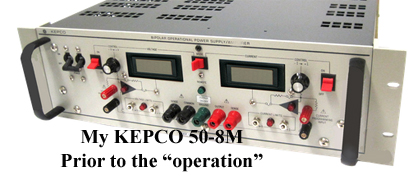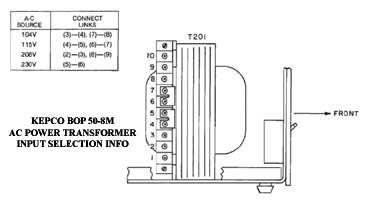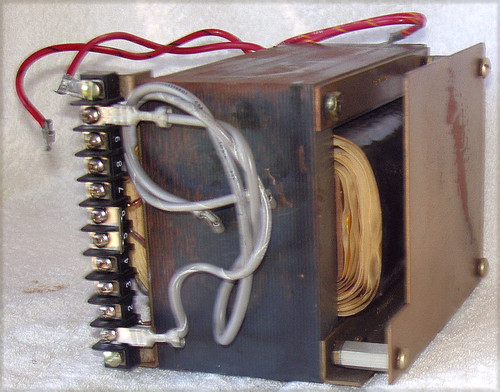HISTORY:
This component has been pulled from a very nice (fully functioning) KEPCO BOP 50-8M!
Why "part out" the KEPCO? I have decided to make this equipment an "organ donor" because I have had it advertised elsewhere as a fully functional unit but no interest, too "high brow" I guess.
Additionally it is VERY HEAVY (this is a FULL rack size unit, approaching 40Kg when it was packed) and I noticed light damage to the steel casing as well (scrape marks due to moving it around over the years).
Originally we acquired this equipment from an international R & D laboratory and used it ourselves for various test and research tasks, although the BOP range of Bi-polar power supplies can undertake many other tasks.
In brief, the KEPCO BOP 50-8M is a Bi-polar power supply providing 0-50V dual supplies at up to 8A current each.
But to be more specific it is much more than a Bi-polar power supply, the unit contains two high speed, high power Op amps and NO capacitors on the output (which can effect the frequency response/speed). The Op amps can operate up to 24Khz (resistive loads) with Ultra low noise, Ultra low ripple and they are MIL spec compliant.
The power Op amps are four quadrant, bi-polar operation with full control of the voltage and current on each channel via the front panel controls OR remote control/programming.
This KEPCO BOP 50-8M is not a "spring chicken", date of manufacture was in the late 1990's - not used very often but when it was called upon, it never missed a beat.

KEPCO designs and manufactures some wonderful professional laboratory and industrial power test equipment, take a look HERE for their latest offerings
The company began around the mid 1940's in Queens, New York along with two other very well known power supply design/manufacturing companies Sorenson and Lambda. Of the three companies, only KEPCO remains in Queens and remains an independent company.
Great as a servicing replacement for another KEPCO, although this is unlikely as the components are extremely reliable. Of more interest would be in a custom audio amplifier, those 2x 56V rails will give plenty to work with OR by using the secondaries in series, a nice 800W isolated, AC stepdown transformer 240V to 112V
So, that is the background of this component and now let's get down to describe the component or module I have carefully extracted from the equipment, and where feasible/worthwhile, tested to ensure full functionality.
KEPCO - AC Power Transformer
Physical: E core laminated
Type #: 101 KEPCO KF 9950434GCC 9950446FK2 100-2I90 14340
AC Voltages Input: 104V - 115V - 208V & 230V
AC Voltages Output: 56.5V + 56.5V (two separate windings)
Current capability: Average 8A per secondary (400W + 400W)
Supplied with the original mounting bracket, screws
Metal shield on one side is REMOVABLE (3x bolts), this was in place on the equipment because the AC transformer is physically located very close to the front panel controls especially the analog meters.
DIMENSIONS:
120mm height x 180mm width x 120mm deep
E core runs horizontal, making a wide but not so high transformer which is perfect for the rack mount case it was installed in.
The threaded mounting holes (4x) are spaced 105mm apart in two rows, with the rows being 85mm apart
Weight: 9Kg
COSMETIC CONDITION:
As New (but USED)
NO damage to the laminations or frame
NO damage to the side mounted terminal strip (for the selection of the correct AC input voltage)
Clean although you can see some light oxide (rust) on the top of the transformer laminations - this is light and will in no way affect the transformer operation.
TESTING:
This is what really matters, how does it perform after all these years?
I tested this transformer using my trusty high powered Grundig Variac, first at 230V and then moving up the input to a nominal 240V (our domestic line voltage at the time was actually measuring 248V) Voltage testing has been made BEFORE dismantling the KEPCO BOP 50-8M (so the transformer is under load conditions) and again after extraction from the equipment.
The secondary voltage results are with the 230V AC input supply
Secondary voltages (both windings) are exactly 56.5V AC under load (about 2 amps being drawn at the time from each winding)
NO surprises in operation, initial "buzz" immediately upon turn on (surge current) and then it quickly settles down to a quiet hum - all normal.
I have left the wiring intact for 230V operation, perhaps the wires will come in handy (good length with spade terminations) Currently terminals 5 & 6 are strapped and the AC input (neutral and active) are connected to terminals 1 & 10
If ever there was a need to use a different input AC voltage, here is some information extracted from the user manual













